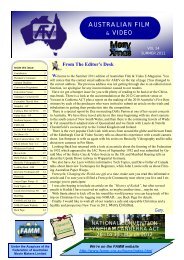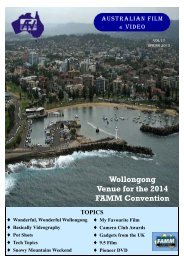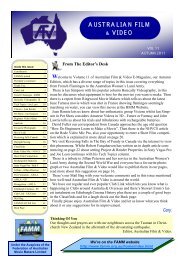20 AFV Winter 2013.pub - Federation of Australian Movie Makers
20 AFV Winter 2013.pub - Federation of Australian Movie Makers
20 AFV Winter 2013.pub - Federation of Australian Movie Makers
You also want an ePaper? Increase the reach of your titles
YUMPU automatically turns print PDFs into web optimized ePapers that Google loves.
ASTOR Theatre, MorpethBy Les TodThis historic building at 85 High Street is rarely seen by the many tourists who visit Morpeth to stroll itsmany craft shops and restaurants, because it is located in a residential street away from the business district.Fewer still would realise that its story as a cinema goes all the way back to 1856. The MorpethPrimitive Methodists had obtained land in 1853 and following a Sunday meeting, the foundation stone <strong>of</strong>their new church was laid on Monday, 12 March 1855.In 1856 the Maitland Mercury reported improvements that had taken place in Morpeth generally, and statedThe High Street, not long ago scarcely a street at all, now shows a fair display <strong>of</strong> cottages - slab, weatherboardand brick, with buildings <strong>of</strong> a public character also. Of these the Primitive Methodist Chapel maybe mentioned, erected within eighteen months, and recently opened. It is a plain structure <strong>of</strong> brick, its dimensions30 feet in width by 40 feet in length, more or less, judging from eye measurement.In 1862, the first Government school in Morpeth was opened on 3 November. Called the National School,it was a non-vested school, meaning that the buildings were not owned by the Government. The schoolwas actually held in the Primitive Methodist Church. The church was rented at a cost <strong>of</strong> £26 per year,. Acommittee <strong>of</strong> seven leading citizens, consisting <strong>of</strong> the Reverend George James <strong>of</strong> the Primitive MethodistChurch; William Chamber, butcher; Andrew Tulip, coal miner; John Wisdom, telegraphist; Duncan Sim,millwright; and J Whytlaw <strong>of</strong> the Commercial Bank, undertook the opening <strong>of</strong> the school. The first teacherwas Mr Ralph Broadbent.At the end <strong>of</strong> 1866, a public school building was erected in High Street and its opening saw the closure <strong>of</strong>church and private schools in the district, including that in the Primitive Methodist building. During earlyJanuary, 1902, Methodists throughout Australia were united in one body, combining Primitive Methodistsand Wesleyan Methodists to form a strong church. The Rev T Rudd was the last Primitive Methodist ministerin Morpeth. After this unification, the use <strong>of</strong> the Primitive Methodist Church building becomes unclear.Film screenings had been held regularly at the School <strong>of</strong> Arts building and also in an open air cinema, andit was in 1921 that the old church was converted into the Aster [correct spelling at that time] Theatre. Itopened on Saturday, 11 June 1921, with Mr R Stephens as proprietor. The Aster was formally licensed asa theatre from <strong>20</strong> May 1921.Its dimensions were 80 feet by 28 feet, with brick and iron walls, iron ro<strong>of</strong> and a floor part timber, partearth. The stage measured 15 by 28 feet. The operating box dimensions were 10 x 10 ft, with iron wallsand a timber floor. The box was also used for the sale <strong>of</strong> tickets.In 1924 the operating box was still being used for the sale <strong>of</strong> tickets and was an addition to the front <strong>of</strong> thebuilding, on the ground floor, with the cinematograph on an elevated wooden platform. Three openingshad been cut in the main wall <strong>of</strong> the building for "rays" to pass through, which had no proper shutters. Theowner was given as R Stephens, <strong>of</strong> Francis Street, Wallsend.A few weeks after this report, a letter was sent to Mr Stephens informing him that the use <strong>of</strong> the operatingbox as a ticket box had to be discontinued.The theatre was also used for many other purposes, apart from the screening <strong>of</strong> films. The Methodist RainbowFair was held there on 12 and 13 October, 1927. On 12 May 1928, the Methodist Spring Fair was advertisedfor the coming October, and the St James Spring Fair was held on 19 September 1928.In 1929 the theatre, now referred to as the Astor, suffered significant damage in a storm. The Chief Secretary'sDepartment wrote to Mr Stephens on 2 May 1929, stating ...Regarding the proposal to construct aPage 42 AUSTRALIAN FILM & VIDEO—VOL <strong>20</strong> WINTER <strong>20</strong>13










